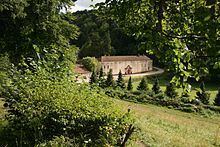 | ||
The Valliscaulian Order was a religious order of the Roman Catholic Church, so named after "Vallis Caulium", or "Val-des-Choux", its first monastery, in Burgundy. It was founded at the end of the twelfth century and lasted until its absorption by the Cistercians in the eighteenth century.
History
The order was founded towards the end of the twelfth century by Viard (also styled Gui), a lay brother of the Carthusian priory of Lugny, in the Diocese of Langres in Burgundy. Viard was permitted by his superior to lead the life of a hermit in a cavern in a wood, where he gained by his life of prayer and austerity the reputation of a saint. Odo (Eudes) III, Duke of Burgundy, in fulfilment of a vow made while on the Fourth Crusade, immediately upon inheriting his estates built a church and monastery on the site of the hermitage. Viard became prior in 1193, and framed rules for the new foundation drawn partly from the Carthusian and partly from the Cistercian observance. In 1203, for the benefit of his soul, of his father's and his predecessors' the Duke Eudes gave all the surrounding forest to the brothers. He made a further gift in 1209. The gifts were confirmed by a bull of Pope Innocent III, 10 May 1211.
The order was formally confirmed by Pope Innocent III, on 10 February 1205, in a rescript Protectio Apostolica, preserved in the Register of Moray, in connection with the House of Pluscardyn. Further endowments were made by the Duke's successors, by the Bishops of Langres, and other benefactors. The tomb of the Dukes of Burgundy, now removed to Dijon, was originally erected at Val-des-Choux; in bas-reliefs of a blind arcading of its base are the only representations of the monks of Val-de-Choux. Among the annual gifts of the Dukes were twenty hogsheads of Pommard wine.
The monks supported themselves in part by salt-making in large stone tubs, for which manufacture they claimed exemption from the tax levied on salt works. The collection of income due them involved the community in endless litigation.
By a Bull of Honorius III, 13 April 1223, the strict original rule established by Viard was relaxed somewhat.
According to the Catholic Encyclopedia, Pierre Hélyot states, that there were thirty dependent houses of the order, but only twenty are known by name. Seventeen of these were in France, the principal one being at Val-Croissant, in the Diocese of Autun; and the remaining three in Scotland. Two local granges are recorded. All houses of the order were priories; references in the statues of 1268 and elsewhere show that priories of the order existed also in Germany.
A complete list of the priors-general has been preserved, from the founder Viard, who died after 1213, to Dorothée Jallontz, who was also abbot of the Cistercian house of Sept-Fons, and was the last grand-prior of Val-des-Choux before the absorption of the Valliscaulian brotherhood into the Cistercian Order.
In the middle of the eighteenth century there were but three brothers of the mother-house; the revenues had greatly diminished, and there had been no profession in the order for twenty-four years. Gilbert, Bishop of Langres, strongly urged the remaining members to unite with the Cistercians, whose rule they had originally, in great part, adopted. The proposal was agreed to, the change was authorized by a Papal Bull of Clement XIII in 1761, and Val-des-Choux was formally incorporated with Sept-Fons in March 1764, the parlement of Burgundy having ratified the arrangement. For the next quarter of a century the monastery flourished under its new conditions; but it was swept away in the French Revolution with the other religious houses of France.
Of the three Scottish houses of the order, Ardchattan, Beauly and Pluscarden, the first two became Cistercian priories, and the third a cell of the Benedictine Abbey of Dunfermline, a century before the dissolution of the monasteries in Scotland.
